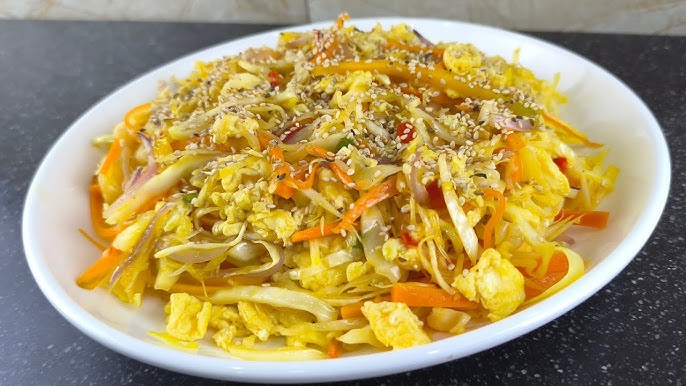Cabbage Stir Fry Recipe: Cabbage stir fry is one of those humble dishes that always surprises you with how good it tastes. Whether you’re short on time or ingredients, this quick and simple recipe will save the day. It’s the kind of dish that checks all the boxes: healthy, budget-friendly, versatile, and packed with flavor. Don’t let the simplicity fool you—when made right, cabbage stir fry can easily become the star of any meal. It pairs perfectly with rice, noodles, or even works as a low-carb main dish.
What makes it truly special? Its adaptability. You can toss in any protein, adjust the spice level, or add whatever veggies you have lying around. Plus, cabbage is available year-round, cheap, and lasts forever in the fridge. Whether you’re cooking for one or feeding a crowd, this dish fits right in. Ready to level up your stir fry game? Let’s get started!
List of Ingredients You’ll Need
Here’s a breakdown of everything you need to make a basic cabbage stir fry. These ingredients are simple pantry staples, but together, they bring serious flavor. You probably already have most of them!
Main Ingredients:
- 1 medium green cabbage, thinly sliced (about 6 cups)
- 2 tablespoons oil (vegetable oil, canola oil, or sesame oil)
- 3 cloves garlic, minced
- 1 inch fresh ginger, grated (optional but adds great flavor)
- 1 small onion, thinly sliced
- 2 tablespoons soy sauce (or tamari for gluten-free)
- 1 teaspoon salt (adjust to taste)
- ½ teaspoon black pepper
- 1 tablespoon rice vinegar or lemon juice (optional, for brightness)
- 1 teaspoon sugar (balances flavors)
Optional Add-Ins:
- 1 carrot, julienned
- Red pepper flakes or chili sauce (for heat)
- Sesame seeds (for garnish)
- Green onions, chopped
- Toasted peanuts or cashews
These ingredients form the core of a great cabbage stir fry. But once you master the base recipe, you can easily riff on it with your favorite flavors.
Kitchen Tools Required
Good tools make cooking easier and faster. You don’t need a fancy setup, just a few kitchen basics:
- Wok or large non-stick skillet – Essential for even cooking
- Sharp knife or mandoline – To get thin, even cabbage slices
- Cutting board
- Spatula or wooden spoon – For stirring
- Mixing bowls – To prep ingredients
A wok is ideal because it handles high heat well and gives you that classic stir-fry texture, but any large skillet will do if that’s what you have on hand.
Choosing the Right Cabbage
Not all cabbages are created equal when it comes to stir fry. Here’s how to pick the best one for the dish you’re making:
Green Cabbage
This is your go-to for classic stir fry. It’s crunchy, holds up well to heat, and absorbs flavors beautifully.
Purple (Red) Cabbage
Tastes similar to green cabbage but slightly sweeter. It’s great for color but tends to bleed into the other ingredients.
Napa Cabbage
Softer and more delicate. Cooks quickly, so keep an eye on it. It has a slight sweetness and is common in Asian cooking.
For a stir fry that’s crisp and flavorful, green cabbage is your best bet. But feel free to mix and match based on what’s available.
Preparation Before Cooking
This is where most people rush—and that’s a mistake. Prepping your ingredients in advance (aka mise en place) makes stir frying smoother, faster, and way more enjoyable.
Step 1: Wash the Cabbage
Remove any damaged outer leaves, then rinse the cabbage under cold water. Pat it dry with a clean towel or spin in a salad spinner to remove excess water. Wet cabbage = soggy stir fry.
Step 2: Slice It Right
Cut the cabbage into quarters, remove the tough core, and slice thinly. Thinner slices cook faster and evenly.
Step 3: Prep the Aromatics
Mince the garlic, grate the ginger, slice the onion. Get everything ready in small bowls so you can just toss them in when needed.
This part might feel tedious, but trust me—it’s the secret to stress-free cooking. Once your prep is done, the actual cooking takes less than 10 minutes.
Step-by-Step Cooking Guide
Let’s get into the real action. This part’s quick, so follow closely.
Step 1: Heat the Pan
Place your wok or skillet over medium-high heat. Add oil and let it heat up until it’s shimmering.
Step 2: Cook the Aromatics
Add the minced garlic, ginger, and sliced onions. Stir constantly for about 30 seconds to a minute. The fragrance should hit you right away—this is where the flavor builds.
Step 3: Toss in the Cabbage
Add the sliced cabbage to the pan. Don’t dump it all at once if your pan is small—work in batches if needed. Stir well to combine with the aromatics.
Step 4: Add the Sauce
Pour in the soy sauce, sugar, and vinegar (if using). Stir fry for about 5–7 minutes, or until the cabbage is tender but still crisp.
Step 5: Season and Finish
Add salt, pepper, and any extra spices or chili flakes. Give it a final toss and taste. Adjust seasoning as needed.
Boom—you’re done! Your kitchen smells amazing, and you’ve just whipped up a killer cabbage stir fry.
Pro Tips for the Perfect Stir Fry
Even though cabbage stir fry is a simple dish, there are a few chef-level tricks that make a huge difference between “just okay” and “crazy good.” These tips will help you nail it every single time.
1. High Heat is Key
Use high heat when stir frying. It’s the only way to get that slight char and smoky flavor without overcooking the cabbage. If the pan isn’t hot enough, the cabbage will release too much water and get soggy.
2. Don’t Overcrowd the Pan
If you throw in too much cabbage at once, it will steam instead of stir fry. Work in batches if necessary. Give the veggies room to move around and sear.
3. Keep it Moving
Stir frequently to avoid burning the aromatics. A good stir fry is all about motion—use a spatula or toss the pan regularly to cook everything evenly.
4. Adjust Seasoning Last
Add your soy sauce and seasonings toward the end, then taste. This helps avoid overseasoning and gives you more control over the final flavor.
5. Add a Splash of Water or Broth (If Needed)
If your cabbage seems dry or starts sticking to the pan, a tablespoon of water or veggie broth can loosen things up without making it watery.
With these tricks up your sleeve, you’ll get a stir fry that’s flavorful, crisp-tender, and far from boring.
Variations to Try
Cabbage stir fry is like a blank canvas. Once you’ve mastered the basics, it’s fun to play around with flavors and textures. Here are a few tasty variations to try out:
1. Cabbage and Carrot Stir Fry
Add one or two julienned carrots along with the cabbage for color and a touch of sweetness. Carrots also hold their crunch well and make the dish more vibrant and nutritious.
2. Spicy Asian-Style Stir Fry
Boost the heat with a splash of chili oil, a spoonful of gochujang, or some crushed red pepper flakes. Add sesame oil and a pinch of sugar for that sweet-heat balance.
3. Garlic Butter Cabbage Stir Fry
Skip the soy sauce and instead cook your cabbage in butter with lots of garlic and a pinch of salt and pepper. Add parmesan at the end for a comforting, cheesy twist.
4. Indian-Style Cabbage Stir Fry
Add mustard seeds, turmeric, and green chilies. Use coconut oil for an aromatic finish and toss in shredded coconut for an authentic touch.
These versions are just the tip of the iceberg—use your imagination and ingredients on hand to create your own signature cabbage stir fry.
How to Add Protein
Want to turn your stir fry into a full-blown meal? Easy. Just add protein. Here’s how:
1. Tofu
Firm tofu is perfect for stir fry. Cube it, press it to remove excess water, and pan-fry until golden. Then toss it in with the cabbage during the last few minutes.
2. Chicken
Thinly sliced chicken breast or thighs cook fast and taste great with soy sauce and ginger. Sear the chicken first, remove it from the pan, then cook your cabbage and add the chicken back in at the end.
3. Shrimp
Quick-cooking and packed with flavor, shrimp can be sautéed in the same pan before the cabbage. They’ll only need 2–3 minutes per side.
4. Eggs
Want a vegetarian-friendly protein boost? Scramble a couple of eggs in the pan before adding the cabbage, then stir everything together.
Adding protein not only makes this dish more satisfying but also keeps you fuller longer, especially if you’re skipping rice or noodles.
Serving Suggestions
Cabbage stir fry is super flexible when it comes to how you serve it. It can be the main dish, a side, or even a filling. Here are a few ideas:
- With Steamed Rice – Classic combo! White, brown, or jasmine rice all work.
- With Noodles – Try it with lo mein, ramen, or even rice noodles.
- In Wraps or Tacos – Spoon it into lettuce wraps or tortillas for a crunchy, healthy bite.
- With Quinoa or Cauliflower Rice – Great for a low-carb or grain-free option.
- As a Side Dish – Pair it with grilled meat, fish, or a fried egg for a simple, balanced meal.
It’s the kind of dish that easily adapts to whatever else is on your plate—or whatever’s left in your fridge.
Nutritional Benefits of Cabbage Stir Fry
Beyond being cheap and tasty, cabbage stir fry is a powerhouse of nutrients. Here’s why it’s worth adding to your weekly meal rotation:
- Low in Calories, High in Fiber
Cabbage is naturally low-calorie and high-fiber, which makes it perfect for weight management and digestion. - Packed with Vitamins
It’s rich in vitamin C, vitamin K, and B vitamins—essential for immunity, bone health, and energy. - Antioxidant Properties
Cabbage contains powerful antioxidants that help protect your cells from damage and reduce inflammation. - Heart-Healthy
The fiber and potassium in cabbage support heart health and may help lower cholesterol levels. - Great for Gut Health
Its fiber content supports healthy digestion, and when cooked with ingredients like garlic and ginger, it becomes even more gut-friendly.
Whether you’re eating clean or just looking to sneak more veggies into your diet, cabbage stir fry delivers.
Make Ahead and Storage Tips
One of the best things about cabbage stir fry is how well it holds up for meal prep. Whether you’re cooking for the week or saving leftovers, this dish is low-maintenance and still tastes great a few days later. Here’s how to do it right:
Making It Ahead of Time
If you’re meal prepping, make a big batch and portion it out into airtight containers. It keeps well in the fridge for up to 4–5 days, making it a solid option for weekday lunches or quick dinners.
If you’re planning to store it longer, keep the cabbage slightly undercooked during the stir fry process. That way, when you reheat it later, it won’t get too soft or mushy.
Proper Storage
- Fridge: Let the stir fry cool completely, then store it in an airtight container. Keep it in the refrigerator and consume within 4–5 days.
- Freezer: Technically, you can freeze it, but cabbage does lose some of its texture. If you must, freeze it in a freezer-safe bag or container for up to a month. Thaw in the fridge overnight before reheating.
Tips to Keep it Fresh
- Store the sauce separately if you’re meal prepping, and mix it in right before reheating for the freshest flavor.
- Avoid overcooking the cabbage the first time. Slightly crisp cabbage reheats better than over-softened versions.
This dish is perfect for prepping ahead—just one less thing to worry about during your busy week.
Reheating Without Losing Flavor
No one wants sad, soggy leftovers. Reheating your cabbage stir fry the right way helps keep the texture and taste fresh—almost like it was just made. Here’s how to do it right:
1. Stovetop Method (Best Option)
- Add a teaspoon of oil or a splash of water to a skillet over medium heat.
- Add the cabbage stir fry and toss occasionally until heated through.
- If it looks too dry, a tiny splash of soy sauce or broth will revive the flavors.
This method gives you the best results, especially if you originally cooked it in a wok.
2. Microwave (Convenient but Tricky)
- Place the stir fry in a microwave-safe bowl.
- Cover with a damp paper towel or loosely place a lid on top (to trap steam).
- Heat in 30-second bursts, stirring in between, until warmed through.
Keep in mind the microwave might soften the cabbage more than you’d like, so use this method only when in a rush.
3. Oven (Least Recommended)
This isn’t ideal for stir fry but can work in a pinch:
- Preheat your oven to 350°F (175°C).
- Spread the stir fry on a baking sheet and cover with foil.
- Bake for about 10–12 minutes until heated.
Stick with the stovetop when possible—it keeps that stir-fried texture alive.
Common Mistakes to Avoid
You might think a simple dish like cabbage stir fry can’t go wrong—but trust me, even small missteps can turn this flavorful dish into a soggy, bland mess. Let’s save you the trouble.
1. Overcrowding the Pan
Cramming in too much cabbage at once traps steam and leads to limp, watery cabbage. Always stir fry in batches if needed.
2. Not Preheating the Pan
If your oil isn’t hot enough when you start, the aromatics won’t sizzle, and the cabbage will steam instead of fry. Wait for that shimmer on the oil.
3. Using the Wrong Cabbage Cut
Thick or uneven slices won’t cook evenly. Aim for thin, uniform shreds so everything cooks at the same pace.
4. Skipping the Aromatics
Garlic, onion, and ginger aren’t optional—they’re essential for flavor. Don’t skimp.
5. Overcooking the Cabbage
You want crisp-tender cabbage, not mush. 5–7 minutes of stir frying is plenty. Keep an eye on the texture.
6. Not Tasting as You Go
Always taste near the end. You might need a touch more soy sauce, a pinch of sugar, or a splash of vinegar.
Avoiding these simple mistakes ensures your stir fry turns out restaurant-worthy, every single time.
FAQs about Cabbage Stir Fry Recipe
1. Can I freeze cabbage stir fry?
Yes, you can, but the texture may change. Cabbage can get soft or watery once thawed. If you freeze it, do so in a freezer-safe container and consume within 1 month. Thaw overnight in the fridge and reheat on the stove.
2. How long can I keep leftovers in the fridge?
Cabbage stir fry lasts up to 4–5 days in an airtight container in the refrigerator. Reheat on the stove for the best flavor and texture.
3. Is cabbage stir fry keto-friendly?
Absolutely! Cabbage is low in carbs and high in fiber, making it a great option for keto diets. Just make sure to use low-carb sauces and no sugar in your stir fry.
4. What oil is best for stir fry?
Neutral oils with high smoke points work best—think vegetable oil, canola, or avocado oil. For added flavor, you can use sesame oil at the end as a finishing touch.
5. How do I make it less watery?
Avoid overcrowding the pan, use high heat, and make sure your cabbage is dry before cooking. Don’t add sauce too early—wait until the cabbage has cooked down slightly.
Conclusion
Cabbage stir fry might just be one of the most underrated dishes in the home-cooking world. It’s easy to make, budget-friendly, and ridiculously adaptable. Whether you’re looking for a light side dish, a veggie-packed main course, or a base for your favorite protein, this recipe delivers—fast.
Once you’ve nailed the basic method, you can get creative with flavors, proteins, and pairings. It’s a go-to recipe that’s as comfortable on a busy weeknight dinner table as it is in your meal prep routine.
So, grab that lonely cabbage from your fridge and turn it into something special. Stir, sizzle, and enjoy every bite. You’ll be surprised how something so simple can taste so good.



